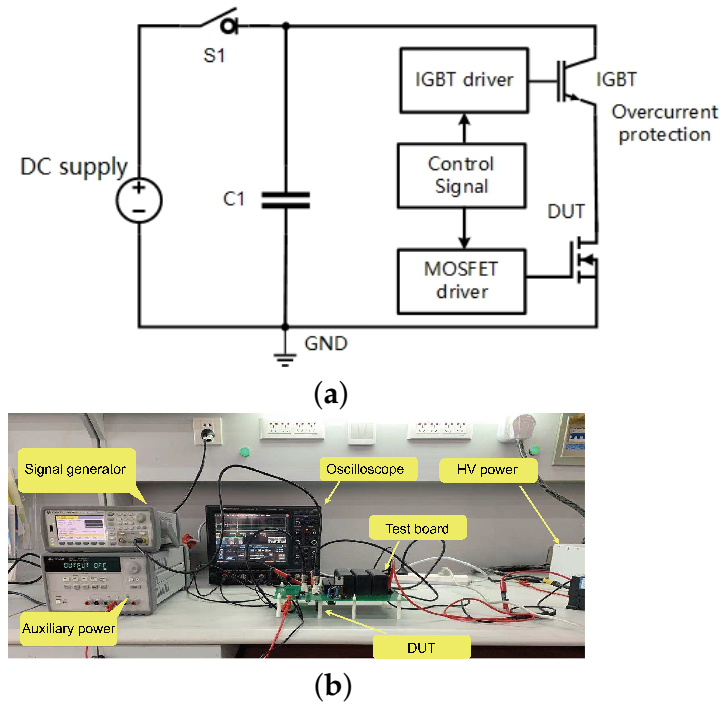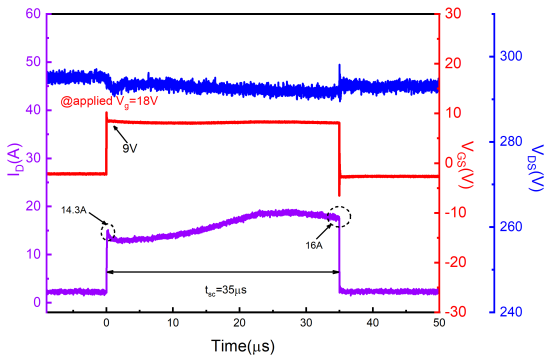Investigation of SiC Trench MOSFETs’ Reliability under Short-Circuit Conditions
Abstract
:1. Introduction
2. Device Structure and Experiment Setup
2.1. Device Structure
2.2. Experiment Setup
3. Experiment Results
3.1. DT-MOSFET
3.2. AT-MOSFET
4. Failure Mechanism
4.1. Finite Element Numerical Simulation
4.2. Post-Failure Analysis
5. Conclusions
Author Contributions
Funding
Institutional Review Board Statement
Informed Consent Statement
Data Availability Statement
Acknowledgments
Conflicts of Interest
References
- She, X.; Huang, A.Q.; Lucía, Ó.; Ozpineci, B. Review of silicon carbide power devices and their applications. IEEE Trans. Ind. Electron. 2017, 64, 8193–8205. [Google Scholar] [CrossRef]
- Li, S.; Lu, S.; Mi, C.C. Revolution of Electric Vehicle Charging Technologies Accelerated by Wide Bandgap Devices. Proc. IEEE 2021, 109, 985–1003. [Google Scholar] [CrossRef]
- Kumar, V.; Maan, A.S.; Akhtar, J. Barrier height inhomogeneities induced anomaly in thermal sensitivity of Ni/4H-SiC Schottky diode temperature sensor. J. Vac. Sci. Technol. B Nanotechnol. Microelectron. Mater. Process. Meas. Phenom. 2014, 32, 041203. [Google Scholar] [CrossRef]
- Kumar, V.; Verma, J.; Maan, A.; Akhtar, J. Epitaxial 4H–SiC based Schottky diode temperature sensors in ultra-low current range. Vacuum 2020, 182, 109590. [Google Scholar] [CrossRef]
- Cao, L.; Guo, Q.; Sheng, K. Comparative evaluation of the short circuit capability of SiC planar and trench power MOSFET. In Proceedings of the 2018 IEEE 2nd International Electrical and Energy Conference (CIEEC), Beijing, China, 4–6 November 2018; pp. 653–656. [Google Scholar]
- Cao, L.; Gao, Z.; Guo, Q.; Sheng, K. Experimental Investigations of SiC MOSFETs under Short-Circuit Operations. In Proceedings of the 2019 IEEE 31st International Symposium on Power Semiconductor Devices and ICs (ISPSD), Shanghai, China, 19–23 May 2019; pp. 227–230. [Google Scholar]
- Wang, Z.; Shi, X.; Tolbert, L.M.; Wang, F.; Liang, Z.; Costinett, D.; Blalock, B.J. Temperature-dependent short-circuit capability of silicon carbide power MOSFETs. IEEE Trans. Power Electron. 2015, 31, 1555–1566. [Google Scholar] [CrossRef]
- Romano, G.; Maresca, L.; Riccio, M.; d’Alessandro, V.; Breglio, G.; Irace, A.; Fayyaz, A.; Castellazzi, A. Short-circuit failure mechanism of SiC power MOSFETs. In Proceedings of the 2015 IEEE 27th International Symposium on Power Semiconductor Devices & IC’s (ISPSD), Hong Kong, China, 10–14 May 2015; pp. 345–348. [Google Scholar]
- Boige, F.; Richardeau, F.; Trémouilles, D.; Lefebvre, S.; Guibaud, G. Investigation on damaged planar-oxide of 1200 V SiC power MOSFETs in non-destructive short-circuit operation. Microelectron. Reliab. 2017, 76, 500–506. [Google Scholar] [CrossRef]
- Liu, J.; Zhang, G.; Wang, B.; Li, W.; Wang, J. Gate failure physics of SiC MOSFETs under short-circuit stress. IEEE Electron Device Lett. 2019, 41, 103–106. [Google Scholar] [CrossRef]
- CREE. Discrete Silicon Carbide MOSFETs. 2011. Available online: https://www.wolfspeed.com/products/power/sic-mosfets (accessed on 4 January 2022).
- Nakamura, R.; Nakano, Y.; Aketa, M.; Noriaki, K.; Ino, K. 1200 V 4H-SiC trench devices. In Proceedings of the PCIM Europe 2014; International Exhibition and Conference for Power Electronics, Intelligent Motion, Renewable Energy and Energy Management, Nuremberg, Germany, 20–22 May 2014; VDE: Nuremberg, Germany, 2014; pp. 1–7. [Google Scholar]
- Baliga, B.J. Fundamentals of Power Semiconductor Devices; Springer Science & Business Media: Berlin, Germany, 2008. [Google Scholar]
- Nguyen, T.T.; Ahmed, A.; Thang, T.V.; Park, J.H. Gate Oxide Reliability Issues of SiC MOSFETs Under Short-Circuit Operation. IEEE Trans. Power Electron. 2015, 30, 2445–2455. [Google Scholar] [CrossRef]
- Pappis, D.; Zacharias, P. Failure modes of planar and trench SiC MOSFETs under single and multiple short circuits conditions. In Proceedings of the 2017 IEEE 19th European Conference on Power Electronics and Applications (EPE’17 ECCE Europe), Warsaw, Poland, 11–14 September 2017; p. P.1. [Google Scholar]
- Kutsuki, K.; Murakami, Y.; Watanabe, Y.; Onishi, T.; Yamamoto, K.; Fujiwara, H.; Ito, T. Effect of surface roughness of trench sidewalls on electrical properties in 4H-SiC trench MOSFETs. Jpn. J. Appl. Phys. 2018, 57, 04FR02. [Google Scholar] [CrossRef] [Green Version]
- Fiorenza, P.; Alessandrino, M.; Carbone, B.; Di Martino, C.; Russo, A.; Saggio, M.; Venuto, C.; Zanetti, E.; Giannazzo, F.; Roccaforte, F. Understanding the role of threading dislocations on 4H-SiC MOSFET breakdown under high temperature reverse bias stress. Nanotechnology 2020, 31, 125203. [Google Scholar] [CrossRef] [PubMed]
- Claeys, C.; Simoen, E.; Put, S.; Giusi, G.; Crupi, F. Impact strain engineering on gate stack quality and reliability. Solid-State Electron. 2008, 52, 1115–1126. [Google Scholar] [CrossRef]
- Nakamura, T.; Nakano, Y.; Aketa, M.; Nakamura, R.; Mitani, S.; Sakairi, H.; Yokotsuji, Y. High performance SiC trench devices with ultra-low ron. In Proceedings of the 2011 IEEE International Electron Devices Meeting, Washington, DC, USA, 5–7 December 2011; pp. 26.5.1–26.5.3. [Google Scholar]
- Peters, D.; Basler, T.; Zippelius, B.; Aichinger, T.; Bergner, W.; Esteve, R.; Kueck, D.; Siemieniec, R. The new CoolSiC™ trench MOSFET technology for low gate oxide stress and high performance. In Proceedings of the PCIM Europe 2017 International Exhibition and Conference for Power Electronics, Intelligent Motion, Renewable Energy and Energy Management, Nuremberg, Germany, 16–18 May 2017; VDE: Nuremberg, Germany, 2017; pp. 1–7. [Google Scholar]
- Wei, J.; Liu, S.; Tong, J.; Zhang, X.; Sun, W.; Huang, A.Q. Understanding Short-Circuit Failure Mechanism of Double-Trench SiC Power MOSFETs. IEEE Trans. Electron Devices 2020, 67, 5593–5599. [Google Scholar] [CrossRef]
- Namai, M.; An, J.; Yano, H.; Iwamuro, N. Experimental and numerical demonstration and optimized methods for SiC trench MOSFET short-circuit capability. In Proceedings of the 2017 IEEE 29th International Symposium on Power Semiconductor Devices and IC’s (ISPSD), Sapporo, Japan, 28 May–1 June 2017; pp. 363–366. [Google Scholar]
- Deng, X.; Li, X.; Li, X.; Zhu, H.; Xu, X.; Wen, Y.; Sun, Y.; Chen, W.; Li, Z.; Zhang, B. Short-Circuit Capability Prediction and Failure Mode of Asymmetric and Double Trench SiC MOSFETs. IEEE Trans. Power Electron. 2020, 36, 8300–8307. [Google Scholar] [CrossRef]
- ROHM. SCT3160KLGC11 Datasheet. 2018. Available online: https://fscdn.rohm.com/en/products/databook/datasheet/discrete/sic/mosfet/sct3160kl-e.pdf (accessed on 12 November 2021).
- Infineon. IMW120R090M1HXKSA1 Datasheet. 2020. Available online: https://www.infineon.com/dgdl/Infineon-IMW120R090M1H-DataSheet-v02_02-EN.pdf (accessed on 12 November 2021).
- Vishay. MKP1848C Datasheet. 2021. Available online: https://www.vishay.com/docs/26015/mkp1848cdclink.pdf (accessed on 4 January 2022).
- Onsemi. FGL40N120AN Datasheet. 2007. Available online: https://www.onsemi.com/products/discrete-power-modules/igbts/fgl40n120an (accessed on 4 January 2022).
- Wang, J.; Jiang, X.; Li, Z.; Shen, Z.J. Short-circuit ruggedness and failure mechanisms of Si/SiC hybrid switch. IEEE Trans. Power Electron. 2018, 34, 2771–2780. [Google Scholar] [CrossRef]
- Sadik, D.P.; Colmenares, J.; Lim, J.K.; Bakowski, M.; Nee, H.P. Comparison of Thermal Stress During Short-Circuit in Different Types of 1.2-kV SiC Transistors Based on Experiments and Simulations. IEEE Trans. Ind. Electron. 2020, 68, 2608–2616. [Google Scholar] [CrossRef]
- Peters, D.; Siemieniec, R.; Aichinger, T.; Basler, T.; Esteve, R.; Bergner, W.; Kueck, D. Performance and ruggedness of 1200V SiC—Trench—MOSFET. In Proceedings of the 2017 IEEE 29th International Symposium on Power Semiconductor Devices and IC’s (ISPSD), Sapporo, Japan, 28 May–1 June 2017; pp. 239–242. [Google Scholar]
- Romano, G.; Fayyaz, A.; Riccio, M.; Maresca, L.; Breglio, G.; Castellazzi, A.; Irace, A. A comprehensive study of short-circuit ruggedness of silicon carbide power MOSFETs. IEEE J. Emerg. Sel. Top. Power Electron. 2016, 4, 978–987. [Google Scholar] [CrossRef]
- Riccio, M.; d’Alessandro, V.; Romano, G.; Maresca, L.; Breglio, G.; Irace, A. A temperature-dependent SPICE model of SiC Power MOSFETs for within and out-of-SOA simulations. IEEE Trans. Power Electron. 2017, 33, 8020–8029. [Google Scholar] [CrossRef]
- Okawa, M.; Aiba, R.; Kanamori, T.; Yano, H.; Iwamuro, N.; Harada, S. Experimental and numerical investigations of short-circuit failure mechanisms for state-of-the-art 1.2 kV SiC trench MOSFETs. In Proceedings of the 2019 IEEE 31st International Symposium on Power Semiconductor Devices and ICs (ISPSD), Shanghai, China, 19–23 May 2019; pp. 167–170. [Google Scholar]
- Sentaurus, T. Manuals; Synopsys Inc.: Mountain View, CA, USA, 2009; Volume 94043. [Google Scholar]
- Yao, K.; Yano, H.; Tadano, H.; Iwamuro, N. Investigations of SiC MOSFET short-circuit failure mechanisms using electrical, thermal, and mechanical stress analyses. IEEE Trans. Electron Devices 2020, 67, 4328–4334. [Google Scholar] [CrossRef]


















| Rated Parameters | Rohm (DT-MOSFET) | Infineon (AT-MOSFET) |
|---|---|---|
| 1200 V | 1200 V | |
| 160 m | 90 m | |
| 17 A | 26 A | |
| Power dissipation | 103 W | 115 W |
| Drive Voltage | 0 V/18 V | 0 V/15–18 V |
| Junction temperature | 175 | 175 |
| Active area | 3.1378 mm | 3.0751 mm |
| Package | TO-247N | PG-TO247-3 |
| Orderable Part Number | SCT3160KLGC11 | IMW120R090M1HXKSA1 |
| Device State | R | R | R |
|---|---|---|---|
| fresh device | >100 M | 1.529 M | >100 M |
| V at 300 V | 8.6 | >100 M | 84 k |
| V at 600 V | 3.36 | 3.05 | 2.36 |
| Device State | R | R | R |
|---|---|---|---|
| fresh device | >100 M | 1.529 M | >100 M |
| V at 300 V | 6.86 | 0.128 M | >100 M |
| V at 600 V | 3.36 | 3.12 | 2.54 |
| Simulation Parameters | DT-MOSFET | AT-MOSFET |
|---|---|---|
| Substrate layer’s Doping (cm) | ||
| Epitaxial layer’s thickness (m) | 10.5 | 10.2 |
| Drift-region doping (cm) | ||
| P-base doping (cm) | ||
| N+ source doping (cm) | ||
| Oxide sidewall’s thickness (nm) | 56 | 63.5 |
| Oxide bottom’s thickness (nm) | 110 | 60 |
| Materials | Melting Point (C) | CTE (K) | Young’s Modulus (GPa) |
|---|---|---|---|
| SiO | 1650 | 0.5 | 75 |
| Poly-silicon | 1410 | 2.9 | 169 |
| SiC | 2700 | 6.58 | 500 |
| Al | 660 | 23.2 | 68 |
Publisher’s Note: MDPI stays neutral with regard to jurisdictional claims in published maps and institutional affiliations. |
© 2022 by the authors. Licensee MDPI, Basel, Switzerland. This article is an open access article distributed under the terms and conditions of the Creative Commons Attribution (CC BY) license (https://creativecommons.org/licenses/by/4.0/).
Share and Cite
Zou, Y.; Wang, J.; Xu, H.; Wang, H. Investigation of SiC Trench MOSFETs’ Reliability under Short-Circuit Conditions. Materials 2022, 15, 598. https://doi.org/10.3390/ma15020598
Zou Y, Wang J, Xu H, Wang H. Investigation of SiC Trench MOSFETs’ Reliability under Short-Circuit Conditions. Materials. 2022; 15(2):598. https://doi.org/10.3390/ma15020598
Chicago/Turabian StyleZou, Yuan, Jue Wang, Hongyi Xu, and Hengyu Wang. 2022. "Investigation of SiC Trench MOSFETs’ Reliability under Short-Circuit Conditions" Materials 15, no. 2: 598. https://doi.org/10.3390/ma15020598
APA StyleZou, Y., Wang, J., Xu, H., & Wang, H. (2022). Investigation of SiC Trench MOSFETs’ Reliability under Short-Circuit Conditions. Materials, 15(2), 598. https://doi.org/10.3390/ma15020598






